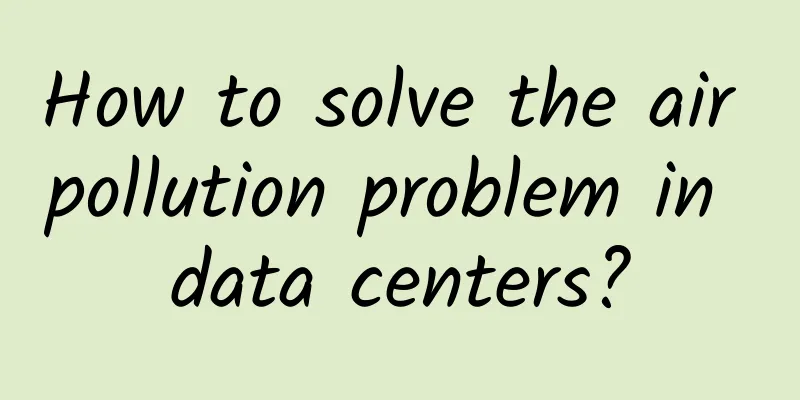How to solve the air pollution problem in data centers?

|
One might think that the issue of air purity in data centers is a settled one. Many people know how to dispose of discarded electronics, and the elimination of dust and contaminants from the air is well understood. However, it turns out that air pollution in data centers is still a serious issue, and attempts to clean up parts of the data center environment may have unintended consequences for the environment inside the data center. First, environmental regulations have removed lead from the solder used to connect components to printed circuit boards (PCBs). The European Union's 2006 Restriction of Hazardous Substances Directive (RoHS) banned the use of lead in solder to avoid the generation of electronic waste, and this ruling will boost the development of the global electronics industry. But some people question this logic, because in fact very little lead can be contaminated from waste into drinking water.
But what does this have to do with air purity? Without lead, solder is not as robust. It is more susceptible to corrosion from contamination, and it also creates tin whiskers that break down into the air and can short out circuit boards. Without lead in solder, electronics are actually more susceptible to air pollution. At the same time, in order to make data centers use less energy and reduce their carbon footprint, some data centers use outdoor air to cool the facilities. This is more efficient than cooling the air inside the building, but it increases the risk of external pollutants entering. “Contaminants can be introduced simply by opening doors during data center infrastructure upgrades or when entering or exiting computer room areas,” said Paul Finch of Kao Data and Chris Muller of Purafil in a recent article. “These contaminants can affect electronic equipment, corrode components, and degrade capabilities at failure points, leading to costly outages in the data center.” In addition, data center locations are changing. Edge computing means deploying IT resources close to end users, which often means digital infrastructure is placed in more urban areas, where there is a risk of particulate matter left over from diesel generators as well as sulfates and other impurities. Even some remote areas have special considerations: Iceland, for example, usually has pure air and volcanic eruptions are infrequent. But in 2010, one of its volcanoes erupted, creating so much particulate matter that it grounded many flights across Europe, but major data centers within 250 meters of the volcano were severely affected. It is suggested that steps should be taken to deal with all of these risks, just as with any other risk, and that these come down to understanding what is happening, planning, monitoring, and preparing to respond. The first is planning: outside air can be cooled indirectly through heat exchangers, and filters should be deployed where there is a risk of pollution. In Iceland, for example, Verne Global's data center campus is equipped with air filters to isolate volcanic ash particles from the air. If the concentration level is too high, the filter may be closed and the data center facility will operate with internal recirculated air. Data centers in places such as London, New York and Paris must develop similar plans to avoid pollution from road traffic. Monitoring is simple: sensors measure pollutants and are wirelessly networked to provide real-time insights into the air conditions in the data center and archived quality reports to identify any problems in advance. All data centers are designed with a level of reliability in mind: keeping the air clean is only part of that. |
<<: F5 Launches F5 Advanced WAF for Multi-Cloud Application Security
>>: Supply Chain Management Is Critical to SD-WAN
Recommend
Linode: Cloud servers in 24 data centers around the world starting at $5/month, new users get $100 for free
It has been a long time since I shared informatio...
Explore F5G industry scenario application practices and promote the digital transformation of enterprises into a new journey
More and more industry cases tell us that F5G (fi...
Operators set different network speeds for 5G packages: some are even worse than 4G
Not long ago, the Ministry of Industry and Inform...
80VPS: Hong Kong dedicated server starting from 350 yuan/month, optional IID/Cloudie/Kowloon/Shatin/CTG/CN2/large bandwidth/high defense, etc.
Last month we shared information about VPS hosts ...
Tencent interview: On a 32-bit 4GB system, accessing 2GB of data, what will happen to the virtual memory?
Hello everyone, I am Xiaolin. Today a reader sent...
Soul-searching question: How many HTTP requests can be sent through a TCP connection?
A classic interview question is what happens from...
The fatal factor affecting TCP connection throughput: HOL
1. What is HOL HOL means Head of line blocking. I...
What is the relationship between API, ESB, ServiceMesh, and microservices?
Introduction I mentioned before that I would like...
HostKvm 10th Anniversary Recharge $50 Get $10, 20% off all items, Hong Kong VPS/Singapore VPS/Japan VPS monthly payment starts from $5.6
Time flies, HostKvm has been established for 10 y...
New space age opens opportunities for edge computing
Satellite communications are starting to become f...
Indoor 5G gets a boost with arrival of small cells
5G offers faster download speeds than previous ce...
China’s 5G leads the world!
[[414223]] This article is reprinted from the WeC...
5G cannot enhance industry?
There are already more than 1,100 “5G+Industrial ...
GSA report: 63 operators around the world have launched commercial 5G services
The latest global 5G network development report f...









